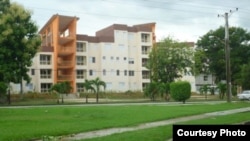In the film Elysium, a fantasy that takes place in the year 2159, the rich live in a ring-shaped space station, well-off and isolated from the earthlings who live below in an overpopulated and ruined Earth. Immigration to Elysium is controlled.
The privileged in Cuba--members of the military elite—have for decades reserved their own Elysium in the so-called zonas congeladas or "frozen zones" of Havana. There are subdivisions such as Nuevo Vedado and Siboney, where, unlike most of the city, homes are well maintained and painted. These houses have no lack of water and the power doesn’t go out. But no one outside the ruling class may live there.
Now, amid the emerging prosperity of private entrepreneurs, visible in restored old mansions, new cars and a standard of living that includes elegant restaurants and vacations in Varadero, the power core wants to do something to ensure the loyalty of their court, the Revolutionary Armed Forces and the Ministry of the Interior. They have set out to fulfill the dream most Cubans hold dear--decent and comfortable housing.
It is not about handing over the keys to the mansions they inhabit, confiscated since 1959 for the local bourgeoisie, but instead to relocate them with their families to a complex of contemporary apartments, with air conditioning and balconies.
The experiment, as in Elysium, adds a factor of isolation from the rest of the population: a fence or perimeter wall blocking the entrance to a complex. By adding clinics, schools, sports facilities, shopping malls and cinemas, it somehow guarantees that residents won’t have to share their lives with ordinary Cubans.
That is the central issue reported by Damien Cave and published in The New York Times. Cave writes of the apartment colors and architecture reminiscent of Florida condos, lending the place a foreign feel. These housing units, Cave continues, are seen as a sign of favoritism.
Independent journalist Augusto César San Martín, who has investigated the topic of special housing for the military in a report for Cubanet, said in an interview with Marti Noticias that the quality of these buildings is much higher than that of the few the State dedicates to cover the needs of the population.
According to San Martin, in places of Havana where houses have collapsed, the government is building what can be described as bunkhouses to relocate the victims. Experience shows that what seems a to be provisional solution may very well be the only solution.
The privileged in Cuba--members of the military elite—have for decades reserved their own Elysium in the so-called zonas congeladas or "frozen zones" of Havana. There are subdivisions such as Nuevo Vedado and Siboney, where, unlike most of the city, homes are well maintained and painted. These houses have no lack of water and the power doesn’t go out. But no one outside the ruling class may live there.
Now, amid the emerging prosperity of private entrepreneurs, visible in restored old mansions, new cars and a standard of living that includes elegant restaurants and vacations in Varadero, the power core wants to do something to ensure the loyalty of their court, the Revolutionary Armed Forces and the Ministry of the Interior. They have set out to fulfill the dream most Cubans hold dear--decent and comfortable housing.
It is not about handing over the keys to the mansions they inhabit, confiscated since 1959 for the local bourgeoisie, but instead to relocate them with their families to a complex of contemporary apartments, with air conditioning and balconies.
The experiment, as in Elysium, adds a factor of isolation from the rest of the population: a fence or perimeter wall blocking the entrance to a complex. By adding clinics, schools, sports facilities, shopping malls and cinemas, it somehow guarantees that residents won’t have to share their lives with ordinary Cubans.
That is the central issue reported by Damien Cave and published in The New York Times. Cave writes of the apartment colors and architecture reminiscent of Florida condos, lending the place a foreign feel. These housing units, Cave continues, are seen as a sign of favoritism.
Independent journalist Augusto César San Martín, who has investigated the topic of special housing for the military in a report for Cubanet, said in an interview with Marti Noticias that the quality of these buildings is much higher than that of the few the State dedicates to cover the needs of the population.
According to San Martin, in places of Havana where houses have collapsed, the government is building what can be described as bunkhouses to relocate the victims. Experience shows that what seems a to be provisional solution may very well be the only solution.




